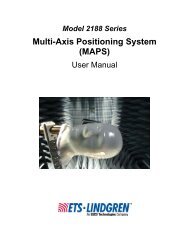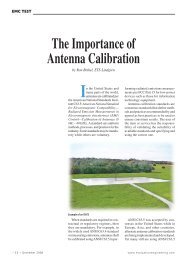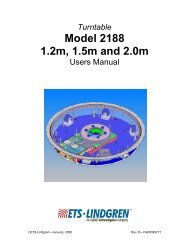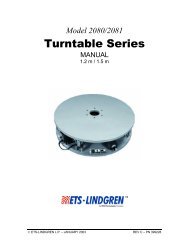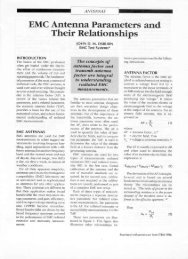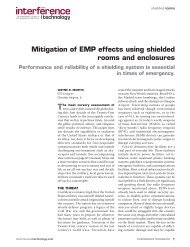Create successful ePaper yourself
Turn your PDF publications into a flip-book with our unique Google optimized e-Paper software.
HIn3637 <strong>Manual</strong> Page — 9<br />
assistance.<br />
Controls, Indicators and Connectors<br />
The instrumentation is housed in a rugged aluminum<br />
chassis. The entire unit is shipped in a convenient<br />
carrying case. The protective foam liner inside the<br />
carrying case has cutouts which accommodate the meter,<br />
the detachable probe and the optional accessories offered<br />
for the meter.<br />
The probe consists of a sensing head containing three<br />
orthogonal coils oriented to pick up the X, Y, and Z<br />
components of the field. The detachable probe plugs into<br />
the multi-pin connector mounted on top of the chassis.<br />
The color coded label surrounding the probe connector<br />
will match the color of the band on the probe cover.<br />
The top of the chassis also contains a ¼ inch stereo<br />
phone jack. The jack is used to connect the battery<br />
charger and also provide access to the recorder output<br />
signal.<br />
The rotary selector switch on the HIn3637 front panel<br />
controls power to the instrument and selects one of five<br />
measurement ranges. The scales are arranged so that<br />
when turned to the first position—400 :T/4 G (or 300<br />
Amps/meter if the optional kit is installed)—the meter is<br />
measuring on its least sensitive scale, i.e., highest range.<br />
As the switch is rotated clockwise, the sensitivity of the<br />
meter increases. As a general rule, readings will be most<br />
accurate when the meter movement shows maximum<br />
deflection without lighting the Over Range indicator.<br />
There are two indicators on the front panel. A "Low<br />
Battery" LED illuminates when the battery voltage is too<br />
low to provide accurate readings. At this point, testing<br />
should be discontinued and the battery recharged or<br />
replaced. The "Over Range" LED illuminates when the<br />
measured flux density exceeds full scale for the selected<br />
range.





